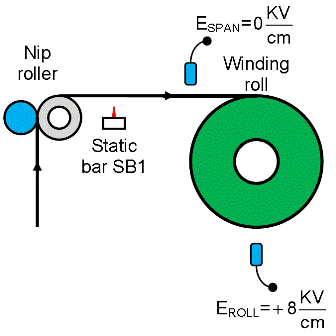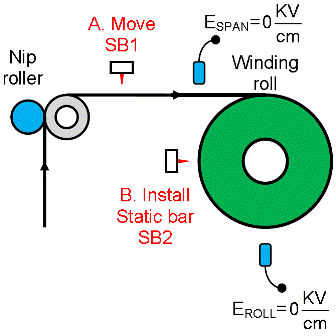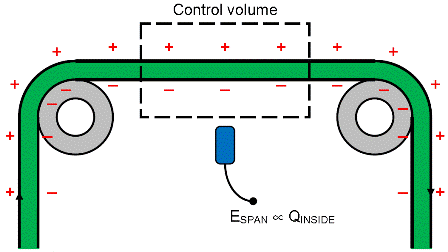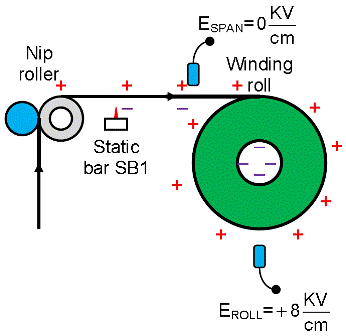Static Quiz - Winding Roll - Answer
- Published: April 23, 2012, By Kelly Robinson
| The tension on the winding roll in Figure 1 is controlled by the nip roller. Static bar SB1 is installed to neutralize static from the nip roller. Fieldmeter reading ESPAN confirms that the electric field near the web after SB1 is zero. However, fieldmeter reading EROLL indicates that the winding roll has positive static. |
 |
| Figure 1: Fieldmeter reading EROLL indicates that the winding roll has positive static. |
|
Careful work has identified two choices in Figure 2 for controlling the electric field EROLL on the winding roll. Choice A is to move static bar SB1. Choice B is to install static bar SB2 to neutralize the winding roll.
|
 |
| Figure 2: Fieldmeter reading EROLL is zero after implementing either A. (Move SB1) or B. (Install SB2). Which is better? |
|
Which choice is better? Why? Choice A (Move SB1) is better. Here’s why.
An electrostatic fieldmeter is the workhorse tool for diagnosing and solving static problems. The fieldmeter responds to the total charge on the web. In your mind’s eye, draw a control volume around the web that is just in front of the fieldmeter. The fieldmeter reading ESPAN is proportional to the charge inside the box. In this case, there are 3 positive charges and 3 negative charges inside the box. So, ESPAN is zero because the sum of the charges is zero. |
 |
| Figure 3: ESPAN is proportional to the charge QINSIDE, which is the total charge inside the box. |
|
The nip roller in Figure 4 deposits positive static on the top surface of the web. Static bar SB1 neutralizes the web by depositing negative static on the bottom surface of the web. While ESPAN is zero indicating that the charges on the web are balanced, the web entering the winding roll has a significant amount of static. Choice A is to move SB1 so that it neutralizes the static on the top surface of the web. With SB1 in this location, the web entering the winding roll is static free. Choice B is to install SB2 to neutralize the winding roll. SB2 simply adds more static charge to the roll that already has a high level of static. With SB2 installed, the roll will exhibit a high level of static when it is unwound in the next operation. |
 |
| Figure 4: The web entering the winding roll has a significant amount of static. ESPAN is zero because SB1 creates balanced static. |




